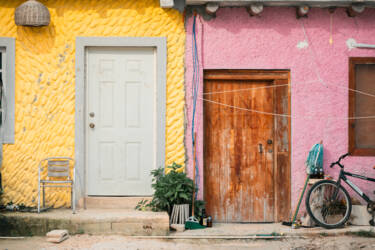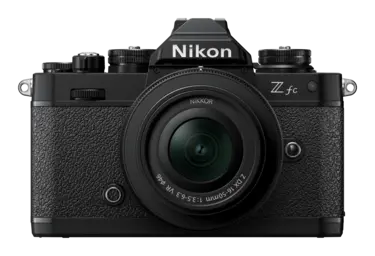Travel and architecture photography 101 with Helin Bereket

Inspiration comes from witnessing the world around you, says Berlin-based travel and architecture photographer Helin Bereket. She dives into DX vs FX bodies, geometry and shooting on the fly
Ever since I was a child, I have loved observing everything around me. I still do. I have found such joy from documenting and sharing my perspective – I simply can’t stop. I don’t have a conscious goal or message I want to share through my photography. I just see things and interpret them.
My photography style adapts to my life. Every place I’m in, every situation, everything in life, triggers thoughts that I then express through my work. Many things inspire me: travel, architecture, landscapes, art, design, music and, above all, my own life. Describing myself visually is much easier for me, and photography has been the best way to do this. When I travel, I shoot travel photography, when I’m alone I take self-portraits, when I’m in a city I take architectural photos. Will I be capturing the same in ten years? Or will I change? Let’s see. For now, here are my best tips and tricks to developing your own style and how to get started.
What’s in my kitbag?

Experiment and learn by doing
Photography is my way of expression. I find inspiration everywhere – my whole photography journey is about experimenting and learning by doing. I didn’t intend to have the style I have now – I think I constantly move somewhere between art, architecture and travel photography. It just evolved that way. My architectural and artistic background, as well as my never-ending desire to travel, have had a naturally strong influence on my style, but I never set any limits for myself. My work is a mixture of things that are on my bucket list, things that I create and things that I stumble upon.
I don’t try to be unique. I just don’t imitate anyone and, by doing so, I remain authentic. For me, it is extremely important that I follow my own path. Even if I really like something and want to try it, I try to create my own version and give it my own notes. When you’re active on social media, you see the same things all the time and it’s hard to be yourself, but I think I’ve managed well so far and that’s still the most important thing for me.
Shoot. Then shoot some more
For aspiring photographers wanting to apply my style of candid photography, my first advice would be: shoot, shoot and shoot some more. Shoot everything around you – your home, family, friends, street, surroundings. Photography is a learning-by-doing process, and the more you photograph, the better you become. If you want to explore the possibilities of photography without limits, you should invest in good equipment. Style is something that evolves over time. Start experimenting and you will find out what interests you most and how you want to capture the moment.

Let geometric shapes, colours and contrast influence you
My subjects reflect my current interests and artistic sensibilities, influenced by my architectural background. Minimalist compositions, geometric shapes, colours and contrasts are elements that often pop up in my work, either separately or together. I’m mainly interested in simplicity. Sometimes it’s already there and I just have to notice it, and then, sometimes, I need to seek it out or zoom in to capture a specific part of a scene to keep it as simple as possible.
As soon as I arrive somewhere, I observe the location, as I want to experience the space first. Then I look for perspectives. Sometimes, an architectural space is interesting in itself, and there is no need to add anything, but sometimes I use these as backdrops and create something new by adding elements like other people or myself when I’m alone. It’s like a collaboration with the architect or creating a new space.
Shoot RAW
I shoot RAW as I like to edit my photos more freely. It’s easier to edit photos that aren’t already processed by the camera, especially when it comes to exposure issues. RAW files consist of more data and simply offer more options.


Use f/8 to f/11 and low ISO during the day
My settings depend on what I shoot, the light and weather conditions. When I photograph architecture during the day, I usually use a medium aperture of f/8 to f/11 and a low ISO of 100 to 200 to get sharp images and Single AF (and continuous autofocus for moving objects).
My shutter speed depends on whether I’m using a tripod or if there are moving people. When I capture architecture in blue hour, I always use a tripod to be able to keep the shutter speed as slow and ISO as low as possible. When I take portraits, I like to have my subject in focus, so I go for wide apertures such as f/1.8, or f/2.8 and telephoto lens to get a shallow depth of field.
I most like to capture landscapes on cloudy days. I use an aperture around f/11 and an ISO of 100. Sometimes, I set the white balance to daylight, sometimes I adjust it during post-production. When shooting moving objects, I keep the shutter speed as fast as possible and use a higher ISO.

Experiment in harsh light, golden and blue hours
I prefer to use natural light as I think it’s irreplaceable. I experiment in every light situation, from harsh light to the golden and blue hours, as I think every time of the day is suitable for a certain type of photography. A portrait in the 12 o’clock sun might not be the best choice, but minimalist architecture with high-contrast shadows, for example, can look very authentic. Inevitably, it always depends on what you want to convey.
Of course, I try to shoot in the best light conditions, but on a spontaneous road trip, for example, you don’t know exactly what you’re going to stumble upon or when. If the light isn’t the best but the subject is interesting, I shoot and edit the photo. In the past, there were only colour filters. Now you have post-production options. In 2023, the possibilities are limitless.
For me, it’s more important to give the viewer the feeling I want to convey than to take completely unedited or extremely sharp photos. I always have my camera ready and try to make the best out of the situation. Sometimes you’re lucky, sometimes you’re not. If your equipment is good enough and you know what you want, you usually end up with something good.


I’d tell my younger self to be less of a perfectionist
I’m still learning to be more flexible instead of a perfectionist. When shooting with natural light in public places, things can always go wrong. There were many moments when I had to reschedule a shoot at short notice – a car may be parked at the spot you picked for your car shoot, or it rains on the shooting day. Perhaps, you’re on a road trip and arrive at a location later than planned and then you’re forced to take photos in the unpleasant midday light. I’ve also travelled for hours to photograph a certain building, but then it was completely overrun by tourists! Overtime, you learn to react spontaneously to such things. That means always having a plan B and staying calm if things go wrong.
For fast, spontaneous shooting use a DX
I love the classic design of the Nikon Z fc. It’s not only aesthetically pleasing, but also very useful thanks to the ‘analogue’ dials, especially when taking pictures with the viewfinder. I like the fluid and fast working autofocus system and the rotating and swivelling touchscreen, which makes it much easier to take photos from certain angles, such as those close to the ground.
I was also totally positively surprised by the image quality of the APS-C sensor, which is exceptional for a camera in this price range. Together, with NIKKOR Z DX 16-50mm f/3.5-6.3 VR and Z DX 50-250mm f/4.5-6.3 VR – I only use DX lenses on the Z fc – there is almost nothing you can’t capture. The camera and the lens range are made for carefree travel and photography.
I use both the viewfinder and camera back screen. When it’s too sunny and bright, or I need to be more stable when capturing movement, for example, the viewfinder is my go-to.

For higher contrast, sharper images use a FX
My main bodies have always been FX, full-frame cameras – the Nikon Z 7II, Nikon Z 7 and Nikon 6 II. With an FX, you can simply shoot higher contrast images, the low-light performance is much better, the images are clearer and sharper, and more megapixels means you can significantly crop an image and still come away with a usable frame. It’s my first choice when it comes to quality.
I use DX especially if I want to be fast and spontaneous. I used Z fc on my trip in the US for the first time and I was really impressed. First, it’s super light. You can take it with you anytime and anywhere. This alone makes you want to pick up the DX more, often even if you have a FX with you.
I mostly take a DX and FX on my trips. If the image quality is very important, I use the FX. If I want to move more freely and flexibly, I go for the DX.

Do you want to take pictures or photograph?
If you’re a beginner or an advancing photographer wanting to invest in a full-frame camera, I would ask yourself if you want to ‘take pictures’ or ‘photograph.’ Mobile phones and compact cameras are designed for amateurs who want to capture some memories but, for me, photography is something else entirely. If you know right from the beginning that you want to advance in photography, you should invest in your equipment.
I started with a compact camera. Then, I got to a point where it wasn’t technically enough anymore. From my experience, if I had invested in a full-frame camera from the start, I would have become professional faster. If you want to explore the infinite possibilities of photography, invest in a full-frame camera.
Discover mirrorless cameras
Featured products
More in travel and architecture

For limitless creativity








